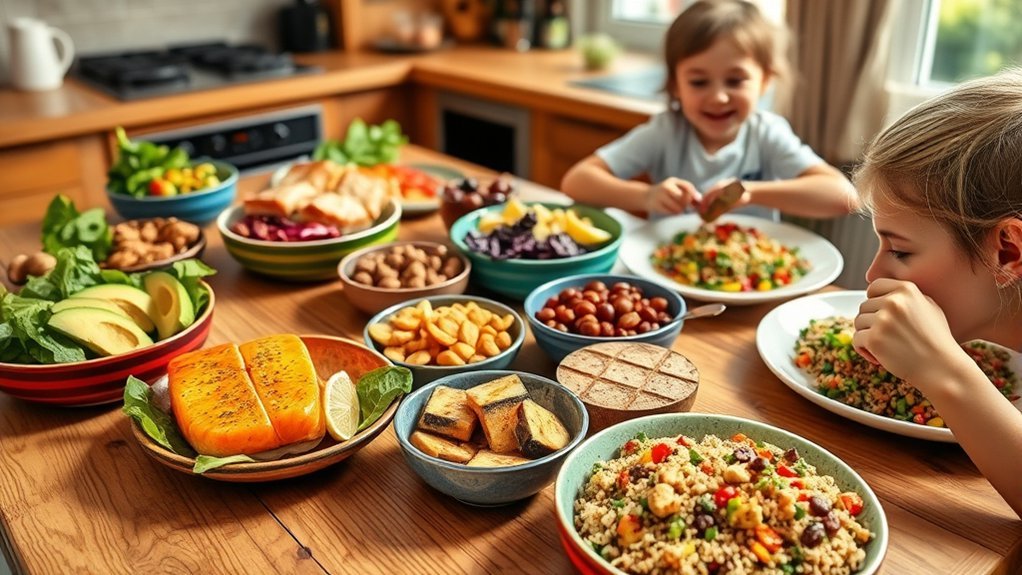When your child enjoys a chicken stir-fry for dinner, it’s not just a tasty meal; it’s also an important source of protein essential for their growth. Understanding various protein sources can help you guarantee your child gets the nutrients they need. Balancing animal-based and plant-based proteins can support their health and development. But how do you mix these options creatively in your child’s diet?
The Importance of Protein for Growing Kids
As your kids grow, ensuring they get enough protein is essential for their development. Protein plays an important role in building and repairing tissues, producing enzymes and hormones, and supporting immune function. It also helps in the formation of muscles, bones, and skin, which are crucial for your child’s overall growth. Research shows that adequate protein intake can enhance cognitive function and improve concentration, aiding in their learning and academic performance. Aim to include a variety of protein sources in their diet, such as legumes, nuts, seeds, and dairy products. Balancing protein with other essential nutrients will give your kids the energy they need for their active lifestyles while promoting healthy growth and development.
Animal-Based Protein Sources
Animal-based protein sources provide essential nutrients that support your child’s growth and development. These proteins are complete, meaning they contain all nine essential amino acids your child needs for ideal health. Incorporating a variety of animal-based proteins can also provide important vitamins and minerals, like iron and B12, vital for energy and cognitive function.
| Animal Protein Source | Key Nutrients |
|---|---|
| Chicken | Lean protein, B vitamins |
| Salmon | Omega-3 fatty acids, vitamin D |
| Eggs | Complete protein, choline |
Plant-Based Protein Options
While animal-based proteins offer numerous benefits, plant-based protein options can also play a significant role in your child’s diet. Foods like beans, lentils, chickpeas, and quinoa are excellent sources of protein and provide essential nutrients. These options not only support muscle growth but also offer dietary fiber, which aids digestion and helps maintain a healthy weight. Incorporating nuts and seeds adds variety and healthy fats, enhancing overall nutritional value. Tofu and tempeh are versatile proteins that can be easily integrated into various dishes. Additionally, plant-based proteins can reduce the risk of chronic diseases later in life. By including a mix of these proteins, you guarantee your child receives adequate nutrition while fostering a diverse palate.
Balancing Protein in Your Child’s Diet
To guarantee your child gets the right amount of protein, it’s crucial to create a balanced diet that includes a variety of sources. This guarantees they receive all necessary amino acids for growth and development. Aim for a mix of animal and plant-based proteins, as each provides unique benefits.
| Protein Source | Serving Size |
|---|---|
| Chicken breast | 3 ounces |
| Lentils | 1 cup cooked |
| Greek yogurt | 1 cup |
Fun and Creative Ways to Include Protein in Meals
Incorporating protein into your child’s meals can be both fun and creative, and there are countless ways to do it. Start by adding Greek yogurt to smoothies or parfaits; it’s creamy and packed with protein. You can also make protein-packed pancakes by mixing in cottage cheese or protein powder. For lunch, try wraps filled with lean turkey, hummus, and colorful veggies, or use beans in quesadillas for a delicious twist. Encourage your kids to help by making homemade protein bars with oats, nut butter, and dark chocolate. Finally, consider introducing protein-rich snacks like edamame or cheese cubes. These options not only enhance nutrition but also keep mealtime exciting for your little ones!
Frequently Asked Questions
How Much Protein Do Children Need Daily Based on Age?
Children need varying amounts of protein daily based on age. Generally, toddlers require about 13 grams, while older children may need 19-34 grams. Always consult with a pediatrician for personalized dietary recommendations.
Are Protein Supplements Safe for Kids?
Like a double-edged sword, protein supplements can be safe for kids if used wisely. However, consulting a healthcare professional is essential to guarantee they meet nutritional needs without overshadowing whole foods in their diet.
Can Excessive Protein Harm My Child’s Health?
Yes, excessive protein can harm your child’s health. It may strain kidneys, lead to dehydration, and cause nutrient imbalances. Guarantee a balanced diet, focusing on age-appropriate protein intake to promote healthy growth and development.
What Are Allergens to Watch for in Protein Sources?
You should watch for common allergens in protein sources like peanuts, tree nuts, soy, eggs, and dairy. Always read labels carefully and consult with your pediatrician if you suspect any allergies affecting your child’s diet.
How Can I Identify Hidden Sources of Protein in Foods?
You can identify hidden protein sources by checking ingredient labels, looking for terms like whey, casein, or soy. Be mindful of processed foods, as they often contain unexpected protein additives that might not be immediately obvious.
Conclusion
Incorporating a variety of protein sources into your child’s diet is essential for their growth and development. Research shows that a mix of animal and plant-based proteins can enhance cognitive function and immune support. By balancing these options creatively, you not only guarantee your kids get the nutrients they need but also help them develop healthy eating habits. So, experiment with meals and snacks—your efforts today can lay the foundation for a lifetime of wellness in your children.
